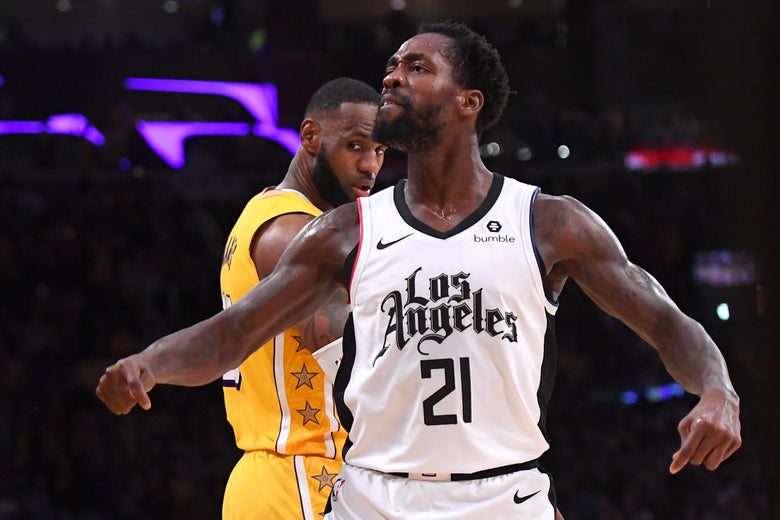
Patrick Beverley celebrates knocking the ball out of bounds. (And everyone knows he knocked the ball out of bounds.)
Jayne Kamin-Oncea/Getty Images
On Christmas in Los Angeles, the Lakers’ LeBron James rose up for a potential game-tying 3-pointer only to have the Clippers’ Patrick Beverley knock the ball out of bounds. The Lakers, down by three points with less than four seconds to go, would seemingly have one more chance to send the game to overtime—a dream conclusion to the NBA’s final showcase game of the 2010s. Instead, this fantasy crashed into modern basketball reality: a replay review, an overturned call, an endgame drained of drama by a panopticon that’s in desperate need of an eye exam.
The most memorable play of the decade in the NBA was probably LeBron’s chasedown block on Andre Iguodala in Game 7 of the 2016 Finals, a feat of athletic brilliance and will that decided a championship and encapsulated a career.
Or maybe it was Kawhi Leonard’s corner jumper in Game 7 of the 2019 Eastern Conference semis, a shot that bounced and bounced and bounced and bounced on the rim until dropping through and sending the Raptors into rapture.
Or perhaps it was Stephen Curry’s 38-foot game-winner against the Oklahoma City Thunder in 2016, the moment when the league’s long-distance revolution reached a transcendent peak.
Watch those replays. Appreciate the fact that modern technology allows us to relive these spectacular highlights, from multiple angles and at variable speeds. Ponder how that Curry heave represents one view of what pro basketball became in the 2010s: a game dominated by guards and forwards and big men taking and making shots that nobody would’ve dared let fly a micro-generation ago.
Yeah, maybe. But on the day after the Clippers’ 111-106 win over the Lakers, I’m feeling more attuned to a pessimistic vision, one in which what we see on the court, whether brilliant or mundane, gets overwhelmed and overturned by off-court autopsies. Do we really have to watch those replays from multiple angles and at variable speeds?
In live action, it was obvious that the pesky Patrick Beverley slapped the ball out of LeBron’s hands. It was a great defensive play, full stop. There’s nothing to debate here, and nothing to adjudicate.
In the last two minutes of an NBA game, though, pretty much everything is justiciable. And so, the refs marched courtside, to commune with the NBA Replay Center in Secaucus, N.J., a facility with so much bandwidth, the league brags, that it “could download the entire digitized Library of Congress—more than 158 million documents—in just over 30 minutes.” One would think that affirming that the ball went off the guy in white would be more straightforward than downloading the vast corpus of human knowledge. But alas, the Replay Center is committed to the perverse project of convincing us that basketball can’t be understood in real time and real speed—that the truth must be found in slow motion.
The truth, as the NBA saw it, was that the ball ticked off LeBron James’ fingertips on its way into the stands. Clippers ball, and 3.6 seconds and two free throws later, a Clippers victory.
League rules dictate that a call can be overturned only if there’s “clear and conclusive” evidence that the original ruling is wrong. The video above is what the NBA considers clear and conclusive: slowed-down footage that bears no resemblance to what the players, refs, and fans see. What that video doesn’t capture is the action coming to a halt, the final moments of a tight game sabotaged by the pointless pursuit of certainty.
Is it impossible to imagine that some stray molecules from Beverley’s flailing limbs grazed the ball’s leather surface as it arced through the air? Is it possible to know what truly happens in a basketball game if the NBA Replay Center isn’t fully equipped with electron microscopes?
Or: Wouldn’t it be perfectly fine—better, even—if we all agreed that the call on the court was good enough and moved on to the next play? Isn’t it simpler and more sensible to decide that what we’ve just seen in front of our faces is what we’ve just seen in front of our faces?
These pleas to rein in replay aren’t novel. Scroll through Twitter on a busy night in the NBA or an NFL Sunday and you’ll find frequent calls to trim the time allotted to reviews, or tighten the criteria for reviewability, or end the reliance on slow motion. But the lesson of this decade is that there’s no going back—that more plays will be deemed reviewable and more technology will be brought to bear to review them.
In all our favorite games, wrongness now gets broadcast in high definition. It’s natural for leagues to want to fix those mistakes. It’s also arrogant, and self-defeating. Basketball can’t be cleansed of errors, and even if it could be the resulting product would be dreadful to watch: a joyless slog of walkbacks and corrections. It would be going too far to say that replay has ruined sports. But if I slow down the decade and zoom in, there’s a vision I can’t unsee: a referee staring at a monitor, taking far too long to render a verdict that nobody needs to hear.
Readers like you make our work possible. Help us continue to provide the reporting, commentary and criticism you won’t find anywhere else.
Join Slate Plusfrom Slate Magazine https://ift.tt/2PZopXD
via IFTTT
沒有留言:
張貼留言